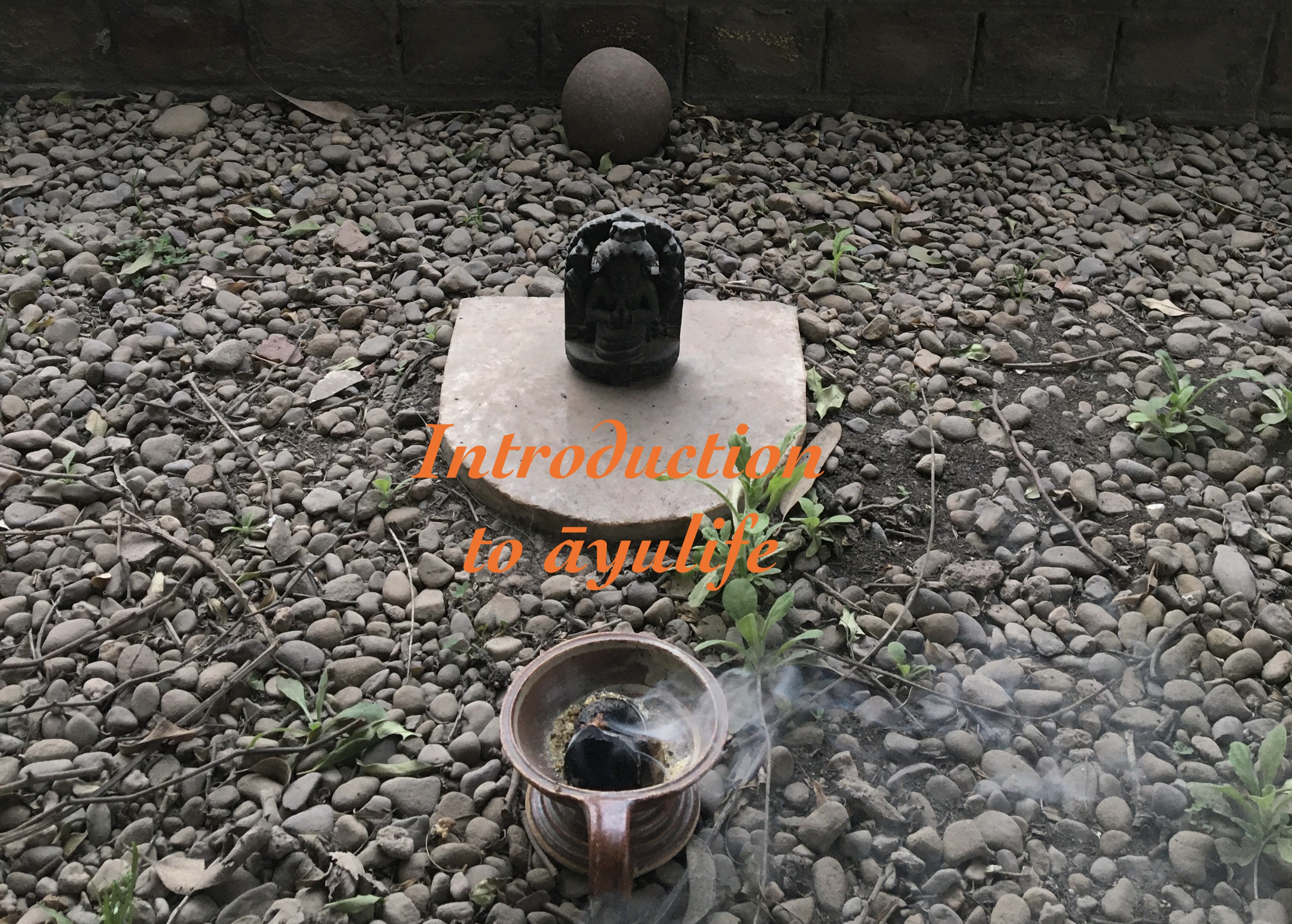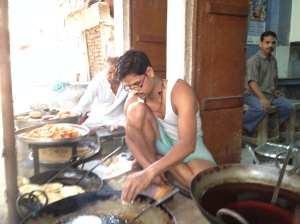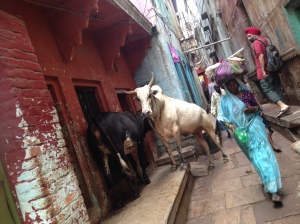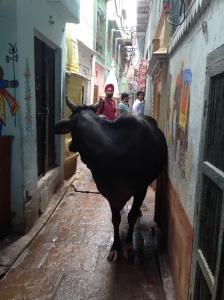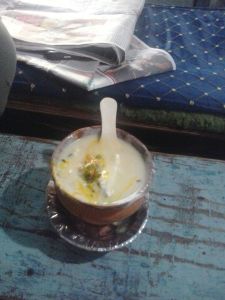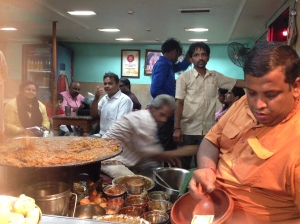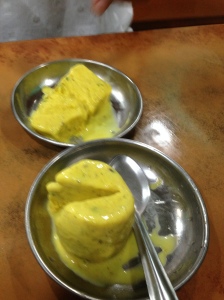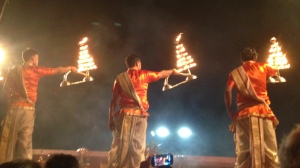TIPS for Recording an Audio Book
First published in Esamskriti https://www.esamskriti.com/sa/Life/TIPS-for-Recording-an-Audio-Book–1.aspx
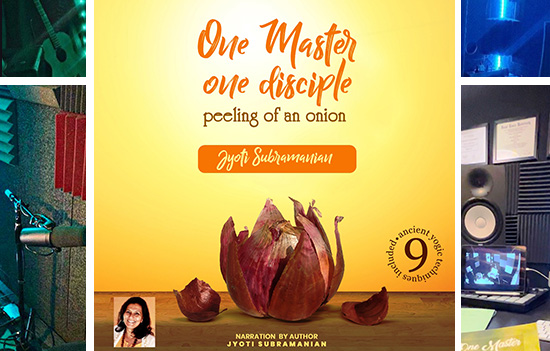
- Kriyacharya Jyoti shares experience of searching for a recording studio in Los Angeles and importantly, gives Tips for Recording an Audio book.
Recently, I decided to convert my autobiography One Master one disciple- peeling of an onion, into an audio book.
By nature preferring written books, I had not invested any time in listening to audio books. It was only recently, after having moved to the US, that I ‘saw’ how many people listen to audio books, while going for a walk, jog or driving. Long commute times and hectic lifestyles had made this a feasible way for people to indulge in their reading habits while getting about their daily chores. This started the germination of the seed to explore audio narration as a mode of literary expression.
Especially interesting is the fact that so far I had ignored this form of expression; having been brought up in an environment of oral recitation of the Ved and Upanishad, the Bhagavad Gita, renditions of Adi Shankaracharya and mantras and chants that had been passed on and kept alive for ages, I should have been more aware of the power of the spoken word.
My psyche was not jogged to the spoken word inspite of accompanying my parents, as a child, to talks of Swami Chinmayananadaji and many Sundays spent in such recitations in my Baal Vihar classes not to miss all those hours on AIR (All India Radio) listening to Havamahal and more recently catching snippets of storytelling by Neelesh Mishra.
First Steps
However, once the idea took hold, I started right in earnest to explore the ways and means to achieve this. As is my habit the first option was Do it Yourself; since for years I was engaged in start-up work for my guru, organising events, venturing into uncharted territories, cities and countries to spread awareness of my Guru and his work on Mahavatar Babaji’s Kriya Yoga. Thus, the thought of DIY came rather naturally to me.
I started reading up on home recording studio setups. Tips to convert a clothes cupboard or wardrobe into a home audio recording studio or a portion of a garage were aplenty. All of them required investment into some tools- recording equipment, buffers to reduce echo, stop sounds from penetrating through the walls, water pipes and flushes. It didn’t help that my neighbour played his drums at all odd hours, along with the barking dogs and the gardeners with their gas powered tools in the neighbourhood, soundproofing seemed a distant dream.
Finally, I decided to take the professional route and engage a recording studio with a sound engineer. This was in the United States and most studios charged an hourly fee which increased if you also wanted a professional engineer to sit through your recordings, which I did.
ACX, the Amazon audible platform had strict specs for the quality of recordings and this was far beyond my expertise. Even though the web is full of sites that give expert help on the use of apps to get the desired outputs. The younger generation may take this as a challenge but I did not want the hassle.

Space Mint Studio in Los Angeles.
Finding a Studio
Next I started a tour of recording studios in the neighborhood. That was an adventure by itself. Some were seedy and not very clean whilst others smelled of weed from musicians who had used the studio the previous night. The majority of them however were quite professional and had dedicated spaces for small and large recording needs. Once I contacted them, most studios responded immediately and most were helpful with their inputs once they learnt I was new to this.
Almost all of them suggested that I engage a professional narrator, someone who was familiar with this medium. But it was my story and I wanted to be the one narrating. I was not going to be daunted by the task ahead.
Eventually, I was lucky to find a studio that was only a 15 minute commute. Evan Mykl, who owned the studio The Space Mint and was also the sound engineer, was very encouraging and helpful. The studio was in his residence and the energy was warm and welcoming. A one person show which was quite after my own heart.

Place to sit and record.
Learning about Narration Tips
Once I decided to do the narration myself, started a flurry of reading up on what to do for voice quality, dehydration, stomach rumbles and yes the biggest deterrent of them all Phlegm!
How long I would be able to record each day was another point to ponder over since most studios required a minimum of two hours of booking. Read on.
Eventually I came upon a regimen that I am sharing with those who wish to walk this path. I started this a fortnight before I started recording.
1. Gave up all caffeinated drinks, coffee being my only one.
2. Drank more water, room temp, with more awareness, gulping the poured water like we do in southern India, without sipping. It helped in keeping the epiglottis clear and throat muscles strong.
3. Started a morning tea drink consisting of mulatthi (liquorice), chotti elaichi (cardamom), and adrak (ginger).
4. Continued with Neti, followed by a practice of my personal dynamic pranayam.
5. Yogasan to boost upper chest and respiratory organs including neck, upper back and diaphragm.
6. Yogic face exercises.
7. I also practiced the svar अ आ इ ई etc and varnamala- क ख ग घ in an exaggerated manner. Intoning them loudly, often in the shower!
8. Practiced my saptsvarmala as in music सा रे गा मा with other combinations
9. I gave up all gluten and milk inclusive food- roti and parathas, dahi, milk, ghee, bread, pasta and pizzas. This was a miracle as the throat became completely clear in a few days of abstinence. I am continuing this even after the recording.
10. I found that eating a besan ka chilla, with spinach and carrots, dhania and ginger before the recording kept my stomach rumbles in control. Some trial and errors moments did happen as fruit made my stomach rumble even though it is good for hydration, especially melons, apples and oranges.
11. Also learnt that the more I chew my food the less the effort the stomach has to make!
It is amazing how sensitive the recording equipment is and how it catches any other sound including the breath. Consistent practice of pranayam for decades helped me with the breath work while reading. Also being a recent grandmother and reading aloud to my granddaughter for the past two years prepared me for this task, albeit unknowingly.
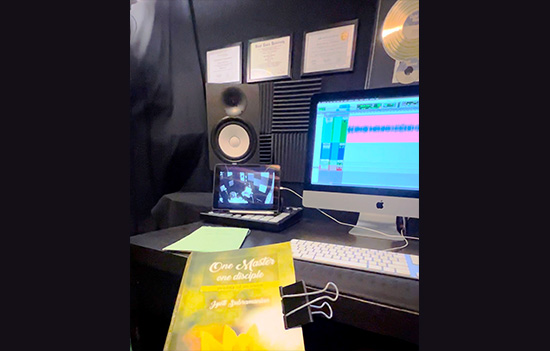
Recording in progress.
All in all the recording went very well and after the first day I realised I could go on recording for two hours straight without a pause. The complete book of 300 pages took me 18 hours of recording over 10 days. Now it is in the editing process. In that sense it is similar to a written book that requires painstaking edits. Similarly, this might require some re-recording later. The editing tools are quite advanced now and many extraneous sounds can be eliminated if the narrator has given space for the edit.
Another interesting thing that I noticed was that many of the recordings of Indian authors have been done by American or British counterparts, for e.g. the narration of Paramahamsa Yogananda’s book Autobiography of a Yogi is by Ben Kingsley. Here, there seems to be a reluctance to use Bharatiya voices for recording spiritual books. I too was gently pressurized to get a more ‘understandable’ accent. But hey, I studied in a missionary school and learnt the Queen’s English not for nothing!
Well the book should soon be available on Audible and other audio book platforms. It did cost me a bit of money to indulge in this wish. It made realise why audio books are more expensive than written ones!
All studio photo credits Evan Mykl, The Spacemint Studio, Los Angeles.
Author Jyoti is a Kriyacharya. Her blog is , U tube Channel
of Alignment and Misalignment on Lunar Eclipse

Last night was full moon and lunar eclipse, it was also Kartik Purnima, Dev Deepavali and Gurpurab. Yes, a pretty auspicious time for many. Yogis to purohits to devotees all use this period to meditate, worship, shower adulations or pray, each according to their own understanding and devotion, as do the lovers of astronomy. I was fortunate to be in Tubac, Arizona for yesterdays event experience, with clear cloudless skies, no light pollution and an unhindered open horizon. As the shadow of the earth progressed over the bright full moon and cloaked the earth with darkness, the stars shined ever so much more brilliantly until the moon now totally eclipsed, turned crimson. Much to be grateful about.
First the alignment
As a yog practitioner, I have for many decades now viewed an eclipse as an alignment of the earth, the moon and the sun according a unique opportunity to align those centres in our own body that correspond to them. The Vedic pind-brahmand philosophy lays much emphasis on the microcosm carrying in entirety the blueprint of the macrocosm and while some revere the external others turn their awareness inwards at such moments using the event to take a leap to understand the universe within.
Before I go further there’s something I need to make clear. I always write propelled by my own experience and realisations strongly believing that no sadhak should take as absolute others realisations. The layers of the mystical are profound and the joy of self discovery can never be understated. Texts and philosophical literature are someone else’s Truth and have only an intellectual value for me and easy to disregard if they don’t pass my self scrutiny. We each one of us have to find our own truth without a need for validation, I sincerely believe. To move on on this path of self discovery with confidence towards what makes us truly happy all we need is a will to do so and the tools to take us forward appear magically. Of course all results are greatly influenced by the fruits of our past karma and present personal efforts.
Here I will note down some musings on these physical eclipse occurrence and how I understand it to affect our body, emotions and mind. These applied realisations have greatly enabled me to bring balance in my life. I have also included a link to a meditation I recorded after this event at the end of this section.
As mentioned earlier during an eclipse, whether full or partial, there is a corresponding full or partial alignment of the sun, the earth and the moon and this reflects in our body in different ways, I have found. Our left and the right naadis in yogic terms the Ida and Pingala correspond to the Chandra (moon) and Surya (sun), connecting to the two polarities in our brain- the right and left hemispheres. The earth corresponds to our mool prakriti, the innate nature of our body, While consciously aligning these spheres during the eclipse we enable ourselves to flow with the circadian rhythm of the universe reducing conflict in our emotional and mental body- the manomaya kosha. Living without conflict with nature ones nature becomes that of stillness and the physical body receives the benefit of health of such peaceful living without stress.
Another realisation I experienced is that of the moon, the sun and the earth aligned along the spine. The moon in the Agnya Chakra indicating the mind, the Sun in the Anhad Chakra as distributor of Pran and the earth on the muladhar representing everything physical, earth, water, fire air and the space occupied when alive, in death all these return to the source.
Finally, as the moon corresponds to the mind, and it is well known how the lunar cycle effects our mind, when the shadow of the earth passes over the moon enveloping it fully and then the moon reemerges as the shadow passes, it as if a veil is removed, a veil of ignorance and the mind full of awe rebirths into a clarity facing the brilliant sun. This outer light is reflected in the inner transformation of the yogi practitioner.
click this 👉🏽 Practicing Alignment on Eclipse Days
Misalignment Galore
-my God/Guru is greater than yours
Of course after this wonderful alignment with nature and the sun and the moon and the earth, I had to open my phone! Being a festive day, I had received many forwards, wishes for Kartik Purnima, for Dev Deepavali, and Gurpurab, usually I delete them all without seeing but I had to open this one didn’t I 🤷🏻♀️, a forward for Gurpurab. Gurpurab is the birth centenary of Guru Nanak Devji, the first Sikh Guru. It was originally from a UK based Sikh organisation, forwarded many times WhatsApp informed me and now forwarded to me by a well meaning friend and it caught my attention. It had a picture of Nanak’s father holding baby Nanak in his arms, and in front of them stood bowing in supplication, many divine beings, of whom I recognised Brahma because of the multiple heads, Vishnu because of the blue body, and Shiva because of the snake around the neck and many other Devi’s and Devata’s, all from the Hindu diaspora. It wasn’t a very well executed picture but it started a flow of thought as to why to make our own Guru or God greater we have to show others down as inferior to them?
Sometimes these representations are malicious, but often it is just the devotion of the devotee to showcase their own as somehow better, greater and grander. Everyone has done this in history and still continue to do so, Vaishnavites show Vishnu as superior to Shiva, followers of Gorakhnath show Krishna washing Gorakhs feet, the worshippers of Shakti show her as more than Shiva, saying Shiva is Shav without Shakti, amongst disciples there is always a rush to prove their own gurus as the true one. This is just within the boundary of one religion, my father once told me how when they were kids in the late 1930’s, Christian missionaries would come to their small village in Kerala and demonstrate how an idol of Krishna sinks when thrown into the well but the idol of Jesus Christ floats. The idol of Krishna was made of metal and Jesus of wood! All the children watching could see that and found it quite foolish. Wonder how many tenets of the religion is broken whith these actions? I am mostly amused by this show, but it is a point to be noted and care taken not to fall into this trap ourselves in the rush to preach and share.
I feel this maybe one of the reason that I found myself pulled towards yog sadhana, where all these concepts can be on a different level of understanding. The body becomes the temple, and all the deities are accommodated within, Shiva and Shakti, Brahma and Vishnu, Ganesh and Hanuman; The Ganga, Yamuna and Saraswati, all equally important or not, their roles dictated by the state the practicing yogi is in. A journey of Self-discovery untainted by the external show. All the forms reveal an inner symphony without any discordant note, to the one who is sensitive.
Removing the veil
Finally, for the yogi, these deities if present, losing their physical attributes amalgamate into Still Love, as they did for me. A core centre of stillness that only translates as Love, shorn of all rites and rituals internal or external. The inner and the outer Guru can stand alone, without support of validation, comparison and or competition.
āyulife channel- a nascent step
After a few months of hiatus, I recently started a process very close to my heart, sharing some simple yogic practices arising out of my sadhana on an open platform. Along with the written word on my blogs and book, I have now included the spoken via my YouTube channel- ayulife.
Yog is a very private and personal journey, in my understanding. Even though thousands may receive the same set of practice, may practice the same Asans, Pranayam and methods of Dharana, it flowers in each of us uniquely because we are each unique and one of a kind. Even though the final result may be the same of Self-Realisation, the path will vary dictated by our individual nature and set of karma.
ayulife is a sincere and joyful attempt at expressing my deep felt and realised understanding of yog, which is one of the six systems- the shad-darshana of Vedic Sanatan way of realisations. System is a very limiting way of describing what is really ‘seeing’ with an inner eye, in-depth and without filters.
The six are each in themselves a vast insight into the philosophy on which is based the present day Hindu “religion’ itself a limiting term for this ocean of enlightened text. I am just giving a brief by line here which according to me is a very inadequate explanation of such profound subjects, but just a taste of the brilliance of the Indic intellect and its range and what it has offered to those like us on the path to savour and explore and discard. All 6, with many sections and sub sections overlap each other and influence the practitioners of one or the other.
.
The shad- darshanas and their originator.
1. Nyaya Darshana- the path of logic and reasoning, removing of ignorance brings an end to suffering, right knowledge brings liberation to the human soul. Rishi Gautama
2. Vaisheshika Darshana- metaphysics, the study of atom (anu), of materials from gross to subtle, of their similarities and differences, of those that exist and the lack of existence, the eternal and non-eternal and Karma- action and reaction, creation and dissolution, to name a few. Rishi Kannada Kashyapa
3. Yog Darshana- the path of uniting the individual spirit to the universal spirit via the 8 limbs of yam, niyam, asan, pranayam, pratyahar, dharana, dhayn and samadhi. Rishi Patanjali
4. Samkhya Darshana- a non-theistic path of dualism, there’s no room for Isvara or God here. The study of Purusha and Prakriti- the moving and unmoving principles, of evolution from material and external pleasures to pure consciousness. Rishi Kapila and IsvaraKrishna
5. Purva-Mimamsa Darshana (Karma Kanda)- Establishes the authority of the Vedas, the magical power of mantras and yagnyas, potency of rituals, the existence of a soul, duties and obligations, embodying the philosophy of Karma Yoga and requirement to move through the 4 varna ashram of brahmacharya, grihasta, vanaprastha and Sanyasa. Rishi Jamini
6. Vedanta Darshana ( Uttara Mimamsa)- Focussing on the Upanishads, emphasising the importance of a Guru, rather than the ritualistic components. Vedanta actually means the end or the conclusion of the vedas. It’s like a synopsis of the 4 vedas Rig, Yajur, Sama and Athrva, taking the nectar from these. It includes the concept of dvait (dualism), advaita (non dualism). Rishi Badarayana
One must remember that the Indic Sanatan philosophy has a strong base of accepting and refuting deep rooted systems and this right is extended to every student of these systems.
I was introduced to these concepts as a child just by being born into a family in which these topics were the norm at home. Discussions and debates amongst my elders revolved around these topics. At a very early age I had started discarding many of these “truths” and was clearly gravitating to the path of Yog, which I find very liberating in its simplicity. I met my Guru Yogiraj Siddhanath from the lineage of Kriya Yoga of Mahavatar Babaji in 1998, first in a vision and then in person. I was under his tutelage and taught the evolutionary practice of Kriya Yoga for 23 years. I have recollection of my years with Lahiri Mahasaya, when I was first initiated into this practice. I am sharing this here because education continues from lifetime to lifetime and expresses and fructifies in this life as per the efforts put in lives past.
You will find many of the concepts from the other darshanas that have influenced me not by reading but directly through realisations, in my writing as well as on my channel.
In ayulife it will be my sincere effort to share those techniques that have helped me over the decades to come to a state of clarity, equilibrium and equipoise and hope it helps others too. The nature of the open platform being such, I am bound to exercise some discretion on the content, for more advanced practice I will be launching an online platform soon. Once again I share the link here. Do subscribe and I thank you all in advance for your support.
Vasudhaiva Kutumbhakam, Not a Deer but a SEER BE
Published in Esamskriti 18. July. 2020
https://www.esamskriti.com/e/Yoga/Worldwide/Vasudhaiva-Kutumbhakam,-Not-A-Deer-But-A-Seer-1.aspx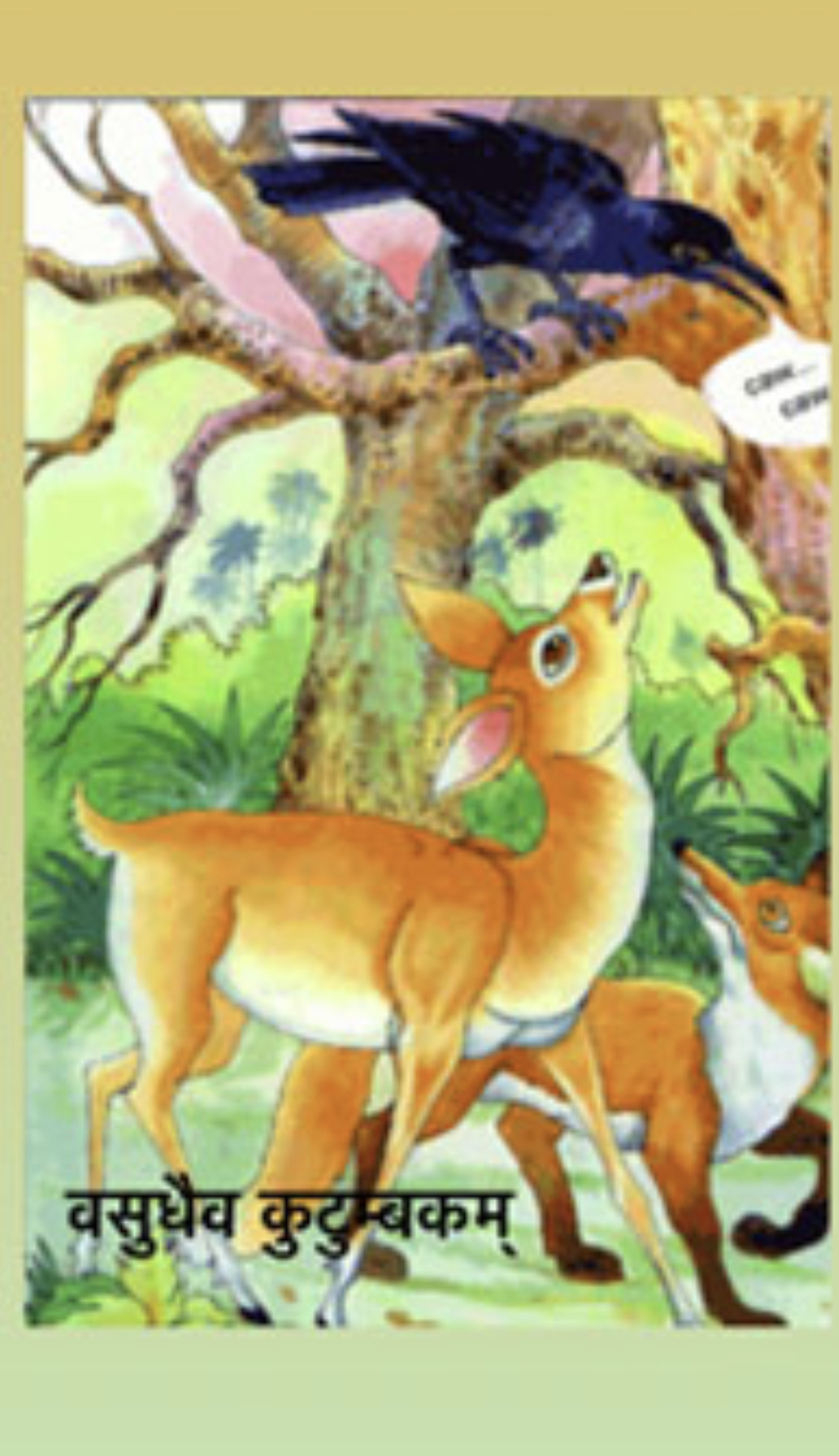
There was a dilemma in my mind as I wrote this blog post that it should not come out as a rant but as a study of the subject of this philosophy in present day context. As always I have followed a stream of thought in my mind and anyone is welcome to disagree with the prognosis I have attempted to arrive at.
This thought process started when I heard this beautiful rendition of an ancient chant performed by The London Symphony and various artists. The process of the thought though went from feeling mellow at the auditory experience of this divine chant to the intellectual interpretation in today’s context to a realisation far beyond in the spiritual field, in course of a few days from the first moment of thought contact.
(You can listen to the performance by clicking on the mantra below)
अयं बन्धुरयं नेतिगणना लघुचेतसाम्।
उदारचरितानां तु वसुधैव कुटुम्बकम् ॥
-(महोपनिषद्,अध्याय४,श्लोक७१)
Meaning of the mantra.
“This one is a friend; this other does not count, is for the small-minded. For those of a magnanimous character, the entire earth is one family.”- Mahōpaniṣad, VI.71.
My mind marvelled at the antiquity and the depth of the Sanatan philosophy in which is rooted the modern day ism of the hindus. At a time when the world is talking of “lives” matter, of women’s and LGBTQ+ rights, of environmental degradation; this wisdom of the earth as family was prevalent on a land thousands of years ago, expressed simply and succinctly in a language as ancient as the thought.
But what is more of a marvel is that both the language and the philosophy is still a living phenomenon as a prayer and an adage even today.
Also to be noted the shlok says vasudha meaning earth and not just manav humans.
Called one of the loftiest Vedantic thought, this shlok is etched on the entrance of the Indian Parliament. Many Vedic chants show this inclusiveness in their realisations. More on this in another article.
Modern Usage
The term “Vasudhaiva Kutumbhakam,” the world as a family, is a popular saying often repeated by present day Gurus and Saints and even politicians in India as they try to showcase the all-encompassing nature of the Hindu religion to the world, the politicians to emphasise the secular nature of the country.
In their eagerness either due to real innocence or carelessness or craftiness, they forget to warn their followers of the pitfalls of such a philosophy applied without filters in today’s sectarian world.
However, this sentiment of caution had been expressed in a story from the Hitopadesha I had heard as a child and which came to mind when I heard this music and was mulling over the philosophy behind it.
The Hitopadesha is a compilation of stories for children, drawn from the more ancient Panchatantra written by Vishnu Sharma dated 1200 BCE to 300 CE. The Panchatantra were written as lessons to teach the art of ruling- (raj) niti- to three princes, who were sent by their father the King to a Brahmin in the forest.
In order to make it interesting to the young princes the stories involve animal figures and were woven together to educate the children in the intricacies of politics and ruling a kingdom. It talks of friends and foes, of making allies and causing dissent amongst enemies for benefit, of war and peace, of loss and profit from alliances and results of hasty actions.
As an adult I went back to read the original unabridged version and was quite literally blown away at the elaborate detail with which the lessons were taught. Atreatise on politics, it is worth inclusion as text in school and college curriculum, which will of course get labelled a move towards Hindutva, seeing the state of the country today.
The later Aesops fables, the Arabian Nights, Grimms fairy tales and many western ballads draw from the Panchatantra for their inspiration.
The first known translation is into Persian and Arabic around 750 CE, while one version reached Europe in the 11th century. Versions are also found in Indonesia, Laos and Thailand. The french teller of fables, fabulist La Fontaine acknowledged his indebtedness to this work.
“Sanskrit literature is very rich in fables and stories; no other literature can vie with it in that respect; nay, it is extremely likely that fables, in particular animal fables, had their principal source in India.”- Max Muller, On the Migration of Fables (source Wikipedia for this info). Max Muller is credited with systematically trying to demolish the Hindu education system replacing it with the Christian Missionary schools, one of whose product is me. Obviously his intent to subvert the Bharatiya mind has sort of backfired with many like me now able to express better our rooted sentiments about Indic philosophy, in English language!
Lesson of the Panchatantra/Hitopadesha
However, coming back to the present chant of vasudhaiva kutumbhakam, in the story the wily jackal quotes this very shloka to befriend the naive deer.
To calm the trepidation of the deer and gain confidence the jackal keeps repeating that we can be friends, for after all we are all one family, that people who think otherwise are mean spirited. The motive being to lead the deer to the pack to be killed and devoured.
The crow, a former friend of the deer keeps warning the deer who foolishly follows the jackal in a euphoric state of bonhomie. In the childhood recital of the story the deer escapes through the intervention of the crow.
The lesson of this story was to beware the princes of foes befriending them by quoting and professing a philosophy of inclusiveness with an ulterior motive of defeating them.
India and Earth family
Leading from there I thought of India in present day scenario, struggling to upkeep her image of a secular country and society. Battered by narratives of pseudo liberals and a far left determined in its hatred of Hindu thought and philosophy, by majority and minority appeasement politics, struggling still to free herself from the emotional burden of 700 years of Islamic rule and then over 400 years of the French and Portuguese in certain parts and the British in the rest of the country.
A country that gave refuge to the persecuted Parsis, the family of Prophet Mohammed and the Tibetans to name a few, is today being called to prove her inclusiveness! I was moved to tears at this thought.
In this context the story of the jackal and deer needs to be more understood, I felt.
When in the name of Vasudhaiva Kutumbhakam (secularism) forces with an agenda (the jackal) lead the good at heart and easily misled folks, who are majority of people, (deer) and the wise seers (crows), who keep warning and are either ignored and called names or are in fact labelled anti peace forces and conspiracy theorists, it is time to take note.
I feel one reason for India’s being conquered time and again has been an adherence to this deep rooted mind set of Vasudhaiva Kutumbhakam and the dilemma it creates in the mind of its people.
This was the first extent of my process of thought how when the philosophy of a country and its majority people is inclusiveness, has to deal with narratives that are fashioned to prove otherwise by forces whom they have to be warned of and somehow exclude from this earth as all-embracing family philosophy.
A very difficult task indeed and which could cause a mental psychotic breakdown in the sensitive or make them put their head in the sand and refuse to engage or keep on embracing the fox as they are torn apart.
As I practice and teach Yog Sadhana and heart centre expansion, unconditional love is a by-product of the yog sadhana as the human transforms into the divine.
It is a moot point to understand how to amalgamate the qualities of a warrior with a lover without losing either.
But I am emboldened when I think of our texts like the Bhagavad Gita which extol to fight to protect the weak, to uphold dharma, of personages like Adi Shankaracharya who came at a time when the Buddhist outlook, it was felt was robbing the Bharatiya mind-set of its warrior like qualities. May be foresaw the future, I wonder!
The invasions and the long stint of being ruled by foreigners subjected Indians to genocide and systemic conversions and economic loot, to famines, taxes and subjugation of our culture? Our Sikh Gurus started preparing well in time for the great fight, gurus like Swami Samarth Ram Das took heed and started training soldiers and warriors for the war.
There was no dichotomy in being a spiritual practitioner, warrior and saviour.
As a result of which India is one of the only country to have survived with its indigenous culture and ancient customs still alive and thriving, visible from the shlok, the subject of this blog. The rest of the world crumbled under Islam and Christian conquests.
Deer and Jackal in the Marketplace
Then cruising along this thought stream my mind came to the field of the market of ideologies, spirituality and religion.
The simple seekers (deer) who are led on a merry dance by charlatan saints, priests, gurus, granthis and maulvis, by mentors and influencers (jackal), do include any others I may have forgotten here! Promising the followers everything from a state of eternal bliss, to virgins in heaven, to a promised land, an egalitarian society. In their greed for name and fame they quote vasudhaiva kutumbhakam or its equivalent! The seer who warns the seekers of the ulterior motives of such charlatans is often shamed and brought down. (That does not mean everyone who is brought down is a seer!)
As a deer today, the danger may not be about being killed but you may be recruited, inducted, radicalised or indoctrinated into the ideology or religious belief system of the jackal, whoever it might be, left or right. Without being aware you become a means for attracting more deer to be slaughtered or recruited.
The corporate world is not free from this phenomenon either; the world seemed to me to be divided today, into deers and jackals with very few seers, people with the ability to see with clarity.
In our personal inner spheres too the senses, and the mind (deer), led outwards by sensual and material attractions (jackal) and our vivek buddhi – the discerning intellect seer (crow) can keep warning us in vain.
At a time like this how can one be sure one is the deer and not the jackal?
When the deer sees without doubt, the jackal for what IT is, the deer becomes the seer.
For me, this clarity of perception only comes as our biases and conditioning is cleared. This can be achieved in many ways, the path of Yog Sadhana being one of them. It is the heightening of our intuitive perception that cuts through the obvious and the apparent and can get to the core motive of the other, and yes of oneself.
Constantly introspecting to see if one is a deer being influenced by a jackal or a jackal recruiting other deers. A seer is a person who is neither but has the wisdom to be aware of both.
The seer, in my realisation, is always rooted firmly in the soil of vasudhaiva kutumbhakam, seeing the earth as one family and embracing all. And though the seer, warns about the fox, can see clearly the motive and agenda and can take any action to deter the jackal from devouring the deer, emotionally, physically and mentally, there is no hate for nor fear of the jackal in the action.
Until this final realisation comes, one swings like a pendulum or seesaw between deer and the seer unless one is the jackal, in which case we are part of a larger pack and may require an immense effort to self-extricate and get away or paying heed to a seer may help us do that.
In conclusion, for me, applied introspection in every situation is the way to identify our roles as deer, jackal or seer.
Pranayam For The Very Young
Article published in Esamskriti; link here
See video here

As a kriya yog teacher I am often asked this question by parents, as to what age children should be introduced to pranayam. My answer to this always is ‘from the womb!’ When mothers to be practice the ayaam of pran- training and tuning the pran to flow smoothly, they plant the seed of it in the child growing in their body.
The practice of pranayam, just like yog, is not a regimen to be done as an exercise three times a week. It is an awareness of the life force that flows through us regulating our every emotion, thoughts and the functioning of our metabolism.
I have had the great honour of students from age two accompanying their parents for my classes, often because there was no one home to mind them and I have been surprised at their absorption and learning in what was a casual attendance.
Many of these children are now in college and some working. Recently, I had the pleasure of seeing my eleven month old granddaughter imitating the pranayam practice which she had seen me do that morning and which has now become a daily play.
The techniques given in the video are a result of the observations on my part of children in my class and in schools where I have shared yog practice with students. To see VIDEO
The gift of Pranayam
It’s a no brainer to even compute the benefits of correct Pranayam techniques for children. It’s like trying to fathom if our breath keeps us alive.
When our children learn the art and science of correct breathing they actually learn the art and science of life. The following plusses have been observed by me in the children who were, even if in a limited way introduced to pranayam.
As children it’s an effortless learning that is imbibed by them as second nature.
The tuned and trained breath fills them with vitality, joy and alertness.
It improves their concentration and helps them to complete tasks at a much faster pace. This leaves more time for rest and leisure, both important ingredients for a happy childhood.
Since the pran is so closely connected to the mind, a calm breath leads to a calm mind giving the children the much needed assistance for dealing with peer pressure, unhealthy competition, bullying and other stressors from the external environment.
Some simple do’s and don’ts
This video is meant to be an introduction for very young children. Of course I don’t expect them to see this video. Hence, it is for their caregivers be it parents, grandparents, aunts, uncles or nannies who must see. They are simple to follow and easy for children to comprehend.
Remember children and infants follow by observation more than instructions, so whatever we want them to do, we must do ourselves. In short walk the talk!
Begin by practicing in front of them, for sure you will ignite their curiosity.
Forcing them can have the opposite effect, so if they get distracted or lose interest let them move away and calmly carry on with the practice yourself so they can observe your discipline despite the distraction.
Make sure this activity does not happen immediately after meals. Give a gap of at least an hour.
Even if they are yet not talking, converse with them as you breathe explaining the benefits of the practice.
Keeping it light hearted and playful benefits both, the teacher and the taught, forming a bond that lasts a lifetime.
Yog sadhana is a wonderful way of life leading to a peaceful co-existence with people inhabiting this earth and with nature. It fosters respect for all that is around us. This is a gift we can and should give to the children who are going to be the keepers of the future world.
To see VIDEO 7 minutes
Authoris a Kriyacharya based in North India.
Holistic Health – A Daily Discipline
BY JYOTI SUBRAMANIAN ON MAY 11, 2021

This piece by me was published in a local Chandigarh epaper. Link below
https://tricityscoop.com/holistic-health-a-daily-discipline/
After recovering from the dreaded COVID, I realised that one of the reasons for my recovery, at home without medication and the positive attitude while in the throes of the symptoms was my relatively disciplined lifestyle and practice of yog sadhana. Holistic health is a consistent effort, treating the body as a temple, taking care of diet and staying away from toxins that affect the body and the mind is a routine that helps at the critical moment of stress, I came to understand deeply at his time.
I am sharing below a combination of asan, pranayam and mudra that can be practiced by everyone and helped me during my illness. All yog contributes towards good health one cannot compartmentalise them into sections, but since the concentration here is specifically on the present pandemic, I am highlighting and modifying those that can be easily practiced by both who are recovering and those unaffected yet new to yog.
Some points to keep in mind:
1. Please wear loose comfortable breathable clothes. This is to let a free-flowing movement of oxygen and pran without restriction through the body.
2. Keep a light stomach, last heavy meal at least three hours before commencing practice, unless otherwise mentioned.
3. Keep to your own level of comfort while practicing the asan, do not overstretch or push your limit. Be comfortable and rested in the posture.
4. You can practice all the following techniques out in the open, facing or with back towards the sun.
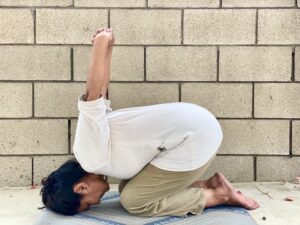
Asan Chalityogmudra (Pic 1) and (2)
1. Sit on your knees or back on your heel, depending on your level of flexibility. You can put a pillow behind your knee if you are comfortable with it.
2. Clasp your hands behind your back at the hip level.
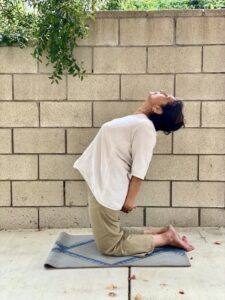
3. Now bend forward breathing out, gently raising and extending the clasped arm behind you to shoulder level. When all the breath is out, gently squeezing your whole body while bent forward.
4. Now slowly breathe in as you straighten up and continue to bend back opening up the chest fully as you keep filling your lungs and extending open your diaphragm. Once again hold the breath in and gently squeeze the body. The arms are now back at hip level.
5. Repeat four to six times.
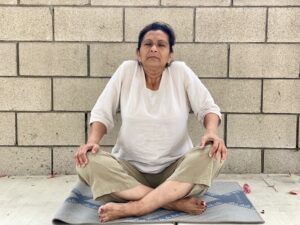
Pranayam (Pic 3,4, & 5)
Set of breathwork for all three parts of the lung. Remember the breath never bursts out or in, you are in control
1. Seat yourself comfortably, on the floor or on a chair. Inhale as you squeeze your shoulders up towards your ears pulling and stretching the spine up. Hold your breath. Exhale as you drop the shoulders down and relax. Repeat 6-10 times. This is for the upper lung area.
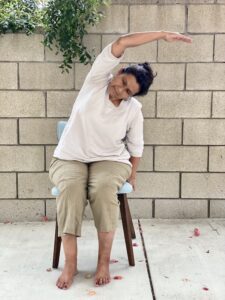
2. Maintain the seating posture. Place your left hand on the floor by your side or on the chair and extend the right arm over the head raising the right shoulder and bending towards the left breathing in as you go into the posture. Hold the posture and the breath. Breath out as you bring your right arm back and lower your right shoulder. This is for the middle portion of the right lung.
3. Now place your right hand on the floor by your side or on the chair and extend the left arm over the head raising the left shoulder and bending towards the right breathing in as you go into the posture. Hold the posture and the breath. Breath out as you bring your left arm back and lower your left shoulder. This is for the middle portion of the left lung.
4. Repeat the alternate sides 6-10 times
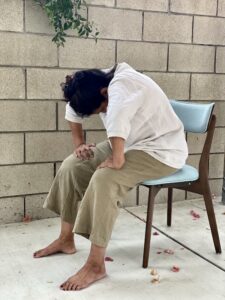

5. Now we come to the lowermost tip of the lungs. Bend forward with both hands placed firmly on your knee. As you inhale, curve your back bringing the shoulders forward towards each other. Hold the breath for a little while. Exhale as you move your shoulders back and extend your chest. Hold the breath. Repeat 6-10 times.
6. In all the above exercise visualise the golden pran along with the oxygen permeating every alveoli of your lungs.
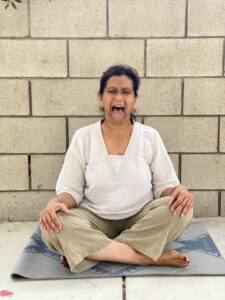
Mudra (Pic 6)
1. Sit comfortably on the floor or a chair.
2. Loosen your shoulders and drop them.
3. Breathe in slowly filling your lungs with oxygen and pran. Feel every alveoli saturated and completely filled with this life-giving pran.
4. Hold your breath for as long as you can comfortably.
5. Then explosively throw the breath out through the mouth as you throw and extend the tongue out. Purging all breath fully. Remember the breath is thrown out from the bottom of the lung.
Take care not to overextend or overstretch yourself during practice. Stay within your comfort zone and stay safe.
About the Author: Introduced formally to yoga at age 11, Jyoti has effortlessly incorporated in her life, the philosophy of yogic living. With a teaching experience since 1999 in Mahavatar Babaji’s Kundalini Kriya Yoga and Siddhanath Yoga, she takes great pleasure in sharing all that she has learnt with others who seek. Author of the book One Master One Disciple, she is an ardent blogger and inspired writer.
www.ayu.yoga www.livefree.yoga
Post Script, not in the original article.
Note to Disciples:
The importance of Grace and Presence of the Satguru.
As a disciple, I have had many divine realisations, many moments of “inner knowingness” as my Satguru Yogiraj Siddhanath calls this; for me they are an aha moment.
So also when I was in the shallow breath stage for two days, as I went deep into myself I felt in every alveoli of my lungs a miniature sun shining and radiating pushing away the clouds of the covid fog. I had no doubt this was the Presence of the grace of my Satguru Yogiraj Siddhanath. When I went deeper and connected with the core disease, I saw present the form of the Mahavatar Babaji comfortably sitting in the middle of the covid cell and laughing. The vision was so funny it set me laughing uncontrollably. I realised that both the disease and the cure was the play of the divine.
I know I might be opening myself to ridicule and disbelief for sharing this incident. But I share it still as it was an important revelation for me. As usual I end with the rider do not blindly believe what others say, base your foundation on your own realisations.
Baba Siri Chand – Yogi, Guru of Gurus and son of Guru Nanak
This article was commissioned by and published online. Posting here as is.
https://www.esamskriti.com/e/Spirituality/Philosophy/Baba-Siri-Chand-~-Yogi,-Guru-Of-Gurus-And-Son-Of-Guru-Nanak-1.aspx
Baba Siri Chand- Yogi, Guru of Gurus, son of Guru Nanak
This is a topic of much trepidation. Though I feel humbled and inadequate to broach this topic, I write purely out of my love and reverence for this great Yogi and mean no disrespect to any other beliefs that may be held by others.
As usual my interpretation is based on personal experiences and I look for no validation. My intention is neither to offend nor refute, nor to please anyone. Enjoy this writing as a heartfelt tribute to the glorious being called Baba Siri Chand, son of Guru Nanak Devji and Mata Sulakhani (or Sulakshana Devi).
A Personal Note
My association in this life with Baba Sri Chand started as a remembrance of a flavour, a fragrance, a remnant from the past that flowed and could be savoured in the present. A difficult morsel to chew for many, but the fact remains that in the Indic thought of birth and rebirth, it firmly understands that the soul is reincarnated in every life to complete past life karmas.
It was early morning on a full moon day in April 2002. I got up in the wee hours and went to my newly constructed temple studio to meditate. The full moon was shining through the large window looking almost as if I could reach out and touch it. As I went in and out of my deep sadhana my eyes opened and lo I saw this face forming in the moon and emerging out of it.
Though not associated in any way with the Udasis in this life, I immediately identified the vision as that of Baba Siri Chand, a figure of no immediate connection at that time. Smiling gently he silently communicated that I should visit his akhara that day itself……I had a lot of appointments planned for that day so I asked if I could come next day? At this, he smiled gently and disappeared back into the moon.
Of course, I dropped everything and after making enquiries, made my way to Kiratpur, the only place connected with Baba Siri Chand that I could find out about at that point of time. Later I got to know that the sacred ground breaking ceremony for this city was done by Baba Siri Chand and the Gurudwara I visited was established by Baba Guruditta, son of Guru Hargobind Ji (1595-1644)
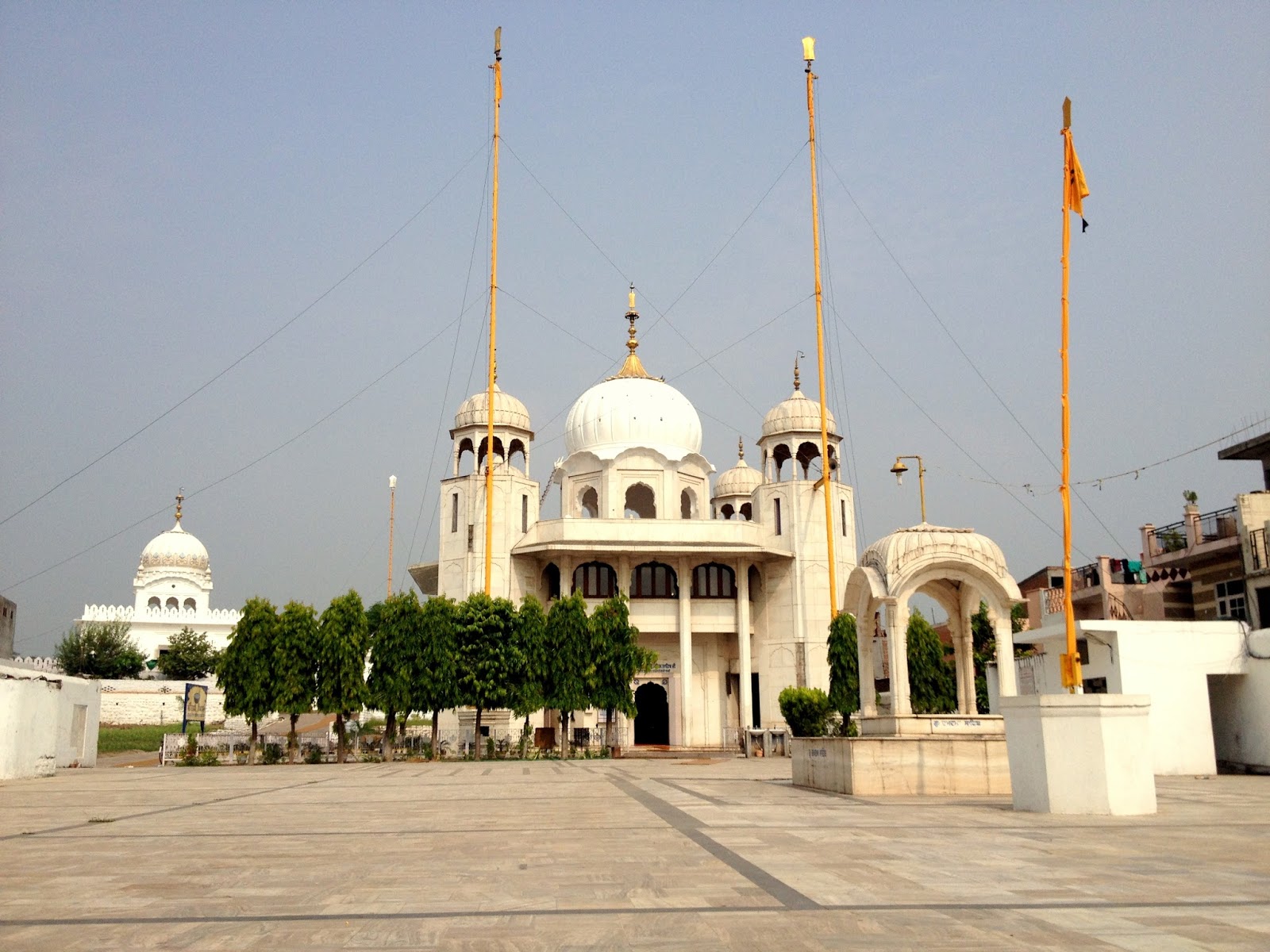
Kiratpur Sheesh Mahal Gurudwara
It was with a wonderful sense of homecoming that I entered the very simple premises of this sacred place. Unlike most Gurudwaras I had visited, this one was very unostentatious and basic. At that time I did not know the significance of this Gurudwara called Gurudwara Sheesh Mahal.
While being summoned by Baba Siri Chand appearing in the full moon, he had asked me to bring, as an offering, a shawl I had bought for my Guru Yogiraj Siddhanath whom I was to meet later in the month at his ashram near Pune, Maharashtra. So I had carried it with me and very reverentially offered it at the darbar sahib and the kind Sikh Udasi there helped me to unfold and lay it on the platform besides the granth. I then went and sat at the Dhuni for a while before heading back to Chandigarh.
This first contact led to a realisation later of past interactions with this evolved being from the time of the sixth Guru, Guru Hargobind Ji also known as Sachhe Patshah, and which mystically led me to discover a gurudwara in Sector 39, Chandigarh ie dedicated to and associated with Baba Siri Chand; and which was also, as was revealed to me, used as an army camp by Guru Hargobind, instrumental in preparing soldiers for the coming resistance to the then ruling Mughals.
Baba Siri Chand 1494-
Early Life


Siri Chand was born in the year 1494, his birthday is recorded as the 8th of September.
It is believed by his devotees that Mata Sulakhani had a vision of Mahadev Shiva while carrying Siri Chand in the womb. Also remembered is the recounting of Nanak’s meeting and debate with the Siddhas in the Siddha Goshti. Here he is said to have defeated Guru Gorakhnath who then told him he will take birth in the Nanak household as his son. Hence, many believe Siri Chand to be an incarnation of Gorakhnath.
According to local tradition, baby Siri Chand was born with natural flesh mundra in his ears, matted locks and ash smeared body, giving additional credence to his connection with the lineage of Guru Gorakhnath.
What warms my heart is the fact that Nanak recognised and respected the interests of his son and instead of forcing him to follow in his footsteps, gave his blessings and sent him for training on his chosen path.
The adolescent Siri Chand excelled in yogic practice and is today recognised as the founder of the ascetic Udasi sect. Not much is known about him (in this period of time) except that he continued to blossom and along with yogic practices spread awareness of his father Guru Nanak Devji’s teachings.
According to Dr Satish Kapoorji, noted educationist, historian and spiritualist, “Siri Chand was invested with yajnopavita (sacred thread) and formally initiated into Vedic literature by Pandit Hardayal. At 11, he went to the gurukul of Acharya Purushottama Kaul in Srinagar for a comprehensive study of religious texts, and subsequently received initiation from Avinash Muni.” Source The Tribune.
It is interesting to note that Guru Nanak himself a Bedi (from Vedi for those who can orally recite entirely one Veda), rebelled against the wearing of this sacred thread yet initiated his son into this ceremony. For me this reiterates my understanding that Sat Gurus guide each one according to their own nature, to follow the path to the divine. The rigidity is mostly brought in by subsequent followers.
His Teachings
The travels of Guru Nanak Devji are called Udasis. It is believed, by followers of Baba Siri Chand, that when his father Guru Nanak returned from his travel, after every Udasi he would bless his son by giving him the choga (long dress or cloak) that he carried during his journey. In a way entrusting Baba Siri Chand with the responsibility of continuing the Udasi Sampradaya. Guru Nanak Devji also gave him the satnam of Ik Onkar Satnaam, Wahe Guru as jaap.
Udasis are also known as Nanakputra, sons of Nanak. Many consider the Udasis to be the original and genuine followers of Guru Nanak, who they believe to be the founder of the Udasi. The word Udasi itself is derived from the word udas as in sad, meaning one is sad until the final merging in the divine, Parmatma.
The most known works of Baba Siri Chand are the Arta Sri Guru Nanak Dev, an Aarti for Guru Nanak and the Matras a presentation of the Udasi philosophy.
What I first learnt about the activities in a Gurudwara dedicated to Baba Siri Chand was from the historical (for me) Gurudwara I visit in Chandigarh. This place is looked after by followers of Maharaj Virsa Singh of Gobind Sadan, Delhi.
They mostly study and read the Jaap Sahib (written by Guru Gobind Singhji) around the Dhuni as they do the havan, the Ardas in the darbar sahib where the Guru Granth Sahib is kept, is the same as in traditional Sikh Gurudwaras. This is followed by a special tribute to Guru Gobind Singhji; also performed is an aarti of Baba Sri Chand and the aarati of Guru Nanak Devji as written by his son Baba Siri Chand. Along with this is recited the Matri of Baba Siri Chandji, Guru Gobind Singh’s Chandi di vaar and the Hanuman Chalisa. (Note that the late Maharaj Virsa Singh did not adhere to what is considered mainstream Sikhism today and the activities of this Gurudwara reflect that and are more inclusive including celebrating Christmas).
It was only when I visited the Baba Siri Chand Akhara in Amritsar that I came to know more of the yogic practices taught by Baba Siri Chand to the Udasi sect. It involved advance Pranayam, Kumbhak and Chakra Bhedan, activation of Kundalini through thokar (thokar is called Chakra Bhedan in Kundalini Yoga).
These are very similar to the practices I do in this life. I was initiated into them by Satguru Yogiraj Siddhanath, who highly reveres and constantly educates his disciples about Baba Siri Chand whom he calls Yogi Shri Chandra. On his visits to Chandigarh he always takes time out to visit the Baba Siri Chand Gurudwara mentioned above.
It is tragic that not much is available in written form about the yogic teachings of Baba Siri Chand. The books I found on my first visit to Amritsar were no longer available on my subsequent visits.

Dhuni at the Baba Siri Chand Gurudwara, Sector 39 Chandigarh

The Adi Granth in the sanctum sanctorum of the 39 Gurudwara
In most gurudwaras of Baba Siri Chand, called Akharas as in the Nath language one will find the Guru Granth Sahib enshrined within the sanctum sanctorum and the Dhuni fire with the chimta (fire tong) of the Nath yogis on the outside. Udasis are known for lighting Dhuna or fire that burns continuously, a tradition followed since ancient times by the Gorakhpanthis of the Nath order.
For me, this combination of the Adi Granth and the Dhuni is a lesson on how while being a householder one can also be detached like ascetic yogis. The true confluence of both and a river I seem to be floating down from past lives.
Baba Siri Chand and the Sikh Gurus
Baba Siri Chand was extremely revered by the subsequent successors of his father. Few incidents stand out. I recount them here as recited to me by devotees.

Guru Amardas with Baba Siri Chand
When Guru Amardas (third Guru 1479-1574) met him he recited the Anand Sahib joyously. He offered Baba Siri Chand his son Mohanji. Baba Siri Chand in turn entrusted Mohanji with the handwritten pothi – notes of Guru Nanak Devji which were later compiled by Guru Arjan Dev into the Adi Granth.

Guru Arjan Dev with Baba Siri Chand in Taran Taaran
When Guru Arjun Dev (fifth Guru 1563-1606) went to meet Baba Siri Chand at Barth Sahib, he had to wait many days as Siri Chand was deep in meditation. At that meeting, after naming the Taran Taaran sarovar, Baba Siri Chand poured water from his holy pot and blessed the lake to never dry up and imbued it with healing properties.
To this day devotees come to take snaan in this sarovar to heal themselves and to be blessed. Later when Baba Siri Chand visited Amritsar, Guru Arjun Devji was composing the Sukhmani Sahib and had got stuck at sixteen verses. Then Baba Siri Chand gave him a new impetus to complete by reciting the shlok- Aad sach, jugaad sach, hai bhi sach, nanak hosee bhi sach, meaning True in the beginning, true throughout the ages, true in the Now, Nanak forever True.
One of Baba Siri Chand’s feats I heard about talks of how when Guru Arjan Dev was made to sit on a hot tawa and when hot sand was being poured over him, Sitting far away in his dera, Baba Siri Chand had his disciples pour water on a sapling, the water steamed and boiled as it was poured and devotees believe that gave relief to Guru Arjan’s suffering.

Guru Hargobind Ji offers his son Guruditta to Baba Siri Chand
Guru Hargobind Ji (sixth Guru 1595-1644) went to take blessings from Baba Siri Chand and he too gave his son, since then to be known as Guruditta, given by the Guru or to the Guru is an interpretation open to the follower.
Guru Hargobind was instrumental in carrying forward the instructions of his father to start preparing an army of steady soldiers for the coming onslaught. This is the period of my connection with both Baba Siri Chand as spiritual Guru and Guru Hargobind as militant Guru. His instructions of Miri and Piri, temporal and spiritual swords, have been carried forward, resonating very deeply with my practice in this life too.

Maharana Pratap offering respect to Baba Siri Chand.
Besides the Guru’s other great emperors also came to meet Baba Siri Chand. One such person was Maharana Pratap, who came to seek his blessings in Udaipur when Babaji was visiting the city. It is said that Emperor Jahangir sent his personal elephant with his soldiers to escort Baba Siri Chand to his court but the elephant could not even lift his blanket. This way Babaji sent the emperor a lesson on ego.
Teachings through Miracles
For me miracles is a science, acting faster than the human brain can comprehend so they seem unexplainable to the ordinary mind. To bend and override laws of nature to their will seems to be an act of child’s play and our Gurus’s lives are full of such acts which they apparently accomplished with no effort. Importantly, most of these miracles are to teach lessons in humility, compassion and courage to those witnessing them.

Baba Siri Chand reaches out reaches out to pluck Dharam Chand and bring him back to earth.
In a very dramatic story, Baba Siri Chand is depicted reaching out with a long arm reclaiming his nephew Dharam Chand from his brother Lakshmi Chand as he and his wife leave for their heavenly abode apparently as penance for killing animals during shikar. He does this out of compassion to save the lineage of his father Guru Nanak.
Later he is shown feeding the hungry baby milk from his big toe, thus completing the role of father and mother. Which for me was a lesson in showing the presence of both male and female energy in this great evolved being. He went on to teach how the discriminations in gender is created by humans and has no relevance in the realm of the divine.
When once Yakub Khan, Governor of Kashmir went to meet him full of anger, ready to trample the area underfoot Baba Siri Chand calmly picked up a burning log of fire from the dhuni and planted it firmly on the ground, and lo behold it sprouted leaves and came alive again.
Once again by a simple act Siri Chand taught a lesson to Yakub Khan on how anger harms and burns one to ashes and how by overcoming it new life can be born and immediately calmed him.
There are many other incidents of Baba Siri Chand – bringing forth fresh water by the seaside, bringing dead animals and people alive, bestowing longevity, stilling the storm to guide ships of a merchant devotee and such are the legends of great beings in India.
It is believed that the great Siddhas came to hear his discourses and see the miracles he did with so much ease. The beauty of these oral traditions are that we get the flavour of the land and the people. For me that is an invaluable ingredient in savouring them.

Baba Siri Chand crossing river Ravi on a boulder.
Finally on a day in 1643, nearing his 150th birthday, Baba Siri Chand is believed to have mounted a boulder and crossed over to the other side of river Ravi. He disappeared from mortal eyes after having promised his disciples that wherever a dhuni is lit, there he will be present. And so to this day the dhuni is lit and kept alive in the Gurudwara Akharas dedicated to him across this country, and his presence felt by the sadhaks sitting around this sacred fire.
āyukahat- life says
Progressing along in my yog sadhana, my mind started to awaken to truths that though they may have been around, were special to me as they unfolded to me, personally. Short one liners would appear in the minds lake along with their realisation. The whole process is like the blooming of a thought bud into a full flower realisation. A process that I enjoy thoroughly as it still continues.
Finding it pompous to post them as “jyoti” kahats – jyoti says or quotes by me 🙄 – I found an ingenious way to deflect them to my studio nomenclature, a nom de plume if you may. They have been posted on social media as they emerge but here I bring them together in a bouquet for those who may want to feel the fragrance, as I do when i reflect upon them. They are to be enjoyed at leisure and I keep coming back to them as new understandings unfold and may add more or refresh the existing from time to time. The reader may find their own understandings from them as they are pretty self-explanatory too.
 I begin not in sequence but with my signature theme of Kurma- the turtle. Since childhood I had a passion for collecting suns and turtle figurines and they both figure in my studio logo, mostly online! The symbolism for both are many and I am not going into that here.
I begin not in sequence but with my signature theme of Kurma- the turtle. Since childhood I had a passion for collecting suns and turtle figurines and they both figure in my studio logo, mostly online! The symbolism for both are many and I am not going into that here.
Copyright for the images used in the following notes is dedicated to the world wide web from where I sourced them unabashedly taking care, as much as I could, that there were no issues but I guessed if they are not marked in some way, it was okay, if not we will find out I’m sure. The content is all mine and as always readers are cautioned to use their own discretions to agree or not.
मंथन स्वाध्याय और गुरूकृपा द्वारा आत्मिक स्पर्श
With inner churning, introspection and grace of the guru, the light touch of the divine is experienced on the soul.
As we step on to and progress on our chosen spiritual path a time comes when emotions and the mind are churned by positive and negative passions; at that moment by self study and grace of the Guru, one gets a glimpse of the Inner Knowingness. During the churning as the inner toxins emerge the steady disciple by self study and the grace of the guru flips the negatives into positives and reclaims the innocence of sahaj and feels the touch of divine love.
The sadhak may then exclaim in wonder, as I did with an outpouring of love for the guru. “You are not this body of flesh and bones that sleeps decays and dies, you are immortal Consciousness!!” तुम देह नहीं नश्वर नासी, तुम अल्लख निरंजन अविनासी”, says Yogiraj Siddhanath, “I am spirit, I am truth, I am love divine, this body mind, a dream of mine.” The yogi practitioner through the churning sees the bridge that connects the human to the divine.
Provoke Thought

Positive agitation births, makes conducive the environment to birth pearls of wisdom. galaxies of infinite realisations. “A consolidated mind is a beautiful mind,” says my guru Yogiraj Siddhanath, a name you will hear repeated many times in all my writings. In spiritual practice a positive stimulation, initiated by the vivek buddhi, leads to rediscovering many truths for the sadhak. Often the popular belief is that meditation profferes a thoughtless state of calm. From personal experience I can say that the mind in a calm manner studies its experiences and as clarity improves nuggets of realisations rise to the fore to be further savoured. It is the very stillness of the mind that allows this steadfast speculation.
True Gurus encourage this quality in their disciples, two of my favorites from the past are Adi Shankaracharya and Kabir who had mastered this to an art. Yogiraj Siddhanath, my satguru often agitates the disciple in order that they don’t fall into a stupor of mindless devotion. “Feel with the mind,” he says, “and think with the heart.”
Clarity begins at Home

Home here of course refers to the self enmeshed in the body of flesh, emotions, mind and intellect. Clarity comes with an intense practice and the self awareness arising from it. Swadhyaya a sub tenet of yog sadhana helps immensely in this. Unless we can see clearly our own motives and agendas without bias through the layers of our mind and emotion, through our intellectually collected information, seeing the external circumstantial occurrences with clarity is near impossible, I have realised. This was the first one in the series and therefore please do excuse the similarity to the very common christian adage about charity!
A Little light can Overcome a Lot of Dark

While watching My Little Pony with my children way back in the 1980’s there was an episode in which the ‘evil’ person, a centaur, half horse half man, had a huge bag pulsating with evil energy which he let loose on the hapless ponies. Let me stop for a moment and say I have never been an advocate of symbolising all good things as white and all evil as black realising how it reflects on a society discriminating based on colour. So here the dark is an opposite of light as in a flame of a candle in a dark room. In fact in spiritual experiences whenever I have experienced light, it has been colourless brilliance. To continue, every time the evil centaur opened the bag of darkness he cried in a thunderous voice, “Behold the power of Darkness”, and the power accompanied with some loud drumbeats would overcome everything, the trees, the river, the lands. Then the ponies managed to get a power of their own. So next time whilst the power of darkness was doing its dance of doom, the little pony opened her small bag and out popped a little rainbow, very minuscule in size, in a small faint voice the pony said, “and behold the power of light.” My girls would gasp at this and feel oh what could this little spark do against the mighty darkness, but lo behold if the rainbow didn’t quickly within a flash drive the centaur, his bag of destruction and the darkness away. I also felt the lesson learnt by my girls then has stood the test of time for them. So this visual was exactly apt for the realisation.
The rainbow of light is encapsulated within our body in the form of our Chakras. The moment we unleash this through yogic practice the dark dis ease of the body (physical, emotional, mental, intellectual) is enlightened. Alternately, a small flame can drive away the pitch darkness in a room. The only act required is to light that spark.
*a note to clarify that in this instance light is used to denote awareness and dark for ignorance, that peace and love can have no colour and or can be all colours. (this was in the original post and I am leaving it here).
I Have No Interest in what Krishna, Buddha, Jesus or Nanak Said, I only know my Satguru has shot me like an arrow and there’s no turning back.
(Sat) Gurus and Divine Guides come from time to time to give direction to an evolving humanity. They come with messages current to that time and age fashioned to awaken and enlighten the contemporary seeker.
Discerning disciples connect with these enlightened beings in every lifetime. Rather than the tradition or schools from the past, these souls find the Spirit in a living Satguru and flow the fast track current. One pointed concentration with vivek and sat buddhi they are magnetically drawn towards the source that is here and now. Some sleeping ones are awakened by the Enlightened One with a swift kick. Thus these realisations become real and immediate for the disciple connected with the living master from life to life.
Yog is a Way of Enlivingness
Yog popularly addressed as yoga is a way of enlightened, enlivened living. It facilitates being present in the moment, the here and now, allowing at the same instance to view the past, present and future.
Daily life becomes a celebration, joyous and liberated. Dissolved completely, flowering into love one cannot but radiate that perfume. Undisturbed and unfettered by the turmoil without. The photograph is the soil of our forest ashram in Pune, where I was introduced to true yog and enlivened living by a Satguru.
kriyayog;antidote
Kriya Yoga is an antidote to the vagrancies of a truant mind, by practice of this a force surfaces that overrides archaic patterns of thoughts. The result is an unadulterated vision and immersion.
There is a whole blog I have written on this topic you can find it here.
Perceive the Possibility of Infinity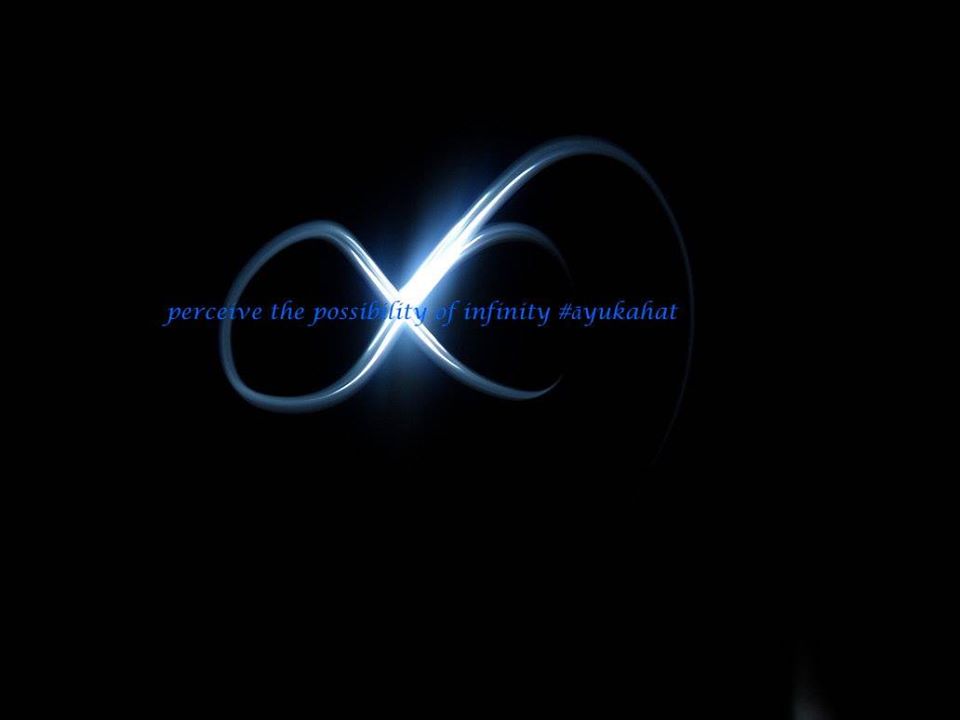
That moment in yogic practice when awareness opens up to the possibility of infinity. The individual on the threshold of the experience, the distilled mind already knowing of its reality… an exquisite vast moment in time indeed. On the threshold of knowing the merging but not yet merged…
An awesome awareness of the individual knowing the consciousness can extend beyond the borders of their physical body, extend beyond even the earth and the solar system, into this universe and many universe.
Do Not Leave Your Mind/Ego with Your Shoes
The mind, the ego is your sense of self which is transformed to the realisation of your Self. The calming of the fluctuations and turbulence of the mind is the basis of yog sadhana. if you have already achieved it you need not enter at all, if you haven’t, leaving it behind you become part of a herd.
I have once again written a detailed blog on this, you can read it here.
If the Mind is Strong it Leads the Pran, If the Pran is Strong it Leads the Mind
Yogiraj Siddhanath, my Satguru instructed as training for practice, “जहाँ चित्त वहां प्राण” meaning where the mind goes there the pran follows. Following his instructions I realised through practice that depending on whether the pran was stronger or the mind, the stronger leads.
I realised that the Pran has an intelligence that by nature leads inwards. the mind by nature leads outwards. The Pran by nature is non-violent, by training the pran through pranayam, the mind is easily led towards Dharana- concentration. Realisations are still coming in about this in practice daily. Updates will follow. The play of the pran and mind, those who taste know. You may like to read more about how to practice dharana here.
In The Ocean be the Drop; In the Drop be the Ocean
In the ultimate stage of yog sadhana, self and god realisation is accomplished when the individual consciousness merges into the universal consciousness; often referred to as the merging of the drop into the ocean; whether the drop absorbs the ocean into itself or the ocean effacing the final layer of separation absorbs the drop into itself, is the in the purview of personal experience. In this concept success is in the effacement of the ego drop and a becoming of the larger vaster consciousness.
For the yogi in action though- the karma yogi- active in the ocean of samsara the feat could be different. Here in fact the same yogi needs an awareness to not dissolve in the ocean or get carried away by the tsunami of action losing identity of individual awareness and becoming one of the crowd.
Maintaining vivek buddhi, the yogi is to navigate the ocean of samsara, the cyclic wheel of birth and rebirth. The karma yogi through informed intuitive action clears the karmic ledger accrued by past actions without creating new karma.
This thought came as I watched the streets swelling with protesters of BLM, having myself protested in agitations for farmer rights in India, I have a personal understanding of how the effect can take over the cause and how narratives can pull the actor into the role until losing sight of that steady inner spark of the spirit one starts to falter towards the ever changing outer glitter.
Adherence to yam and niyam, the first two tenets of yog affirms the yogi to interact with social injustices and discrepancies. In fact it is an inherent part of yog sadhana. To do that while maintaining an awareness on the inner climate of radiating love to all, even the ones perceived to be on the “other” and “opposite” side is the challenge that many can fail.
Learning from the texts of Dead Gurus is like warming your hands on a fire; learning from a Living Guru is like sitting on the Fire.
This early morning thought was a culmination of years of practice with a living Satguru, of numerous initiations by my satguru into evermore subtle, powerful and distilled practices to expand individual consciousness, a result also of many such lifetimes learning directly in the presence of living gurus and finding the path to the living guru in every lifetime.
It is a practice that i have been doing of sitting on a funeral pyre to burn my impurities which I later found was a technique give in the Vignyana Bhairav Tantra, the living satguru having unlocked this from the latent memory bank during an initiation at the ashram. The living satguru make seamless our lives one from the other so it’s like we wake up from one life into another and carry on from where we left off. Often Gurus and disciples move from lifetime to lifetime or disciples are guided to other living masters by the previous ‘dead’ ones. That has been my experience and realisation.
It is a great comfort to many to read scriptures, join organisations and take for themselves masters who have passed and left behind a legacy. The safety net of the qualities attributed to these gurus are not volatile and cannot change from pupil to pupil and that becomes a relief to many as they can manoeuvre placidly in these waters. While a living satguru tests the disciples constantly, keeping them in a high state of alertness so they don’t fall into familiar intellectual pitfalls.
Though many masters are able to communicate from beyond the veil, I personally feel a living Satguru can and is able to take direct action in the pupils evolution towards the spirit. While texts have to be interpreted and hidden nuances nurture an intellectual pursuit instead of a direct experience, however enjoyable that may be. The process can be very slow and take a long time to bring extraordinary effect.
A living satguru, however in an instant can burn the veil of acquired mindsets, flights of fancy and disproportionate ego of understanding, leaving the student disciple with a clarity beyond clear understanding.
Living Master Dead Letter, a conversation with my Satguru Yogiraj Siddhanath
Sanyas, a state not a stage
The varna ashram dharma qualifies sanyas as the fourth stage of life after brahmachrya, grihastha and vanaprastha. Yet sanyas is a state of being, to live steeped in divine consciousness. This state can be achieved and maintained in every stage of life, whether adolescence, householder or retiree. Living is a state of sa nyasa, understanding the body as divine, living in total inner and outer purity does not require an age to achieve, only an inner consciousness often carried over from past life.Mind you here purity is not another word for morality but an innocence of all vice and virtue.
वर्ण आश्रम धर्म ब्रह्मचर्य, गृहस्थ और वानप्रस्थ के बाद संन्यास को जीवन के चौथे चरण के रूप में योग्य बनाता है। फिर भी संन्यास ईश्वरीय चेतना में डूबे रहने की एक अवस्था है। इस अवस्था को जीवन के प्रत्येक चरण में प्राप्त किया जा सकता है और बनाए रखा जा सकता है, चाहे वह किशोरावस्था हो, गृहस्थ हो या सेवानिवृत्त। जीना संन्यास की स्थिति है, शरीर को दिव्य समझना, कुल आंतरिक और बाहरी पवित्रता में रहने के लिए उम्र की आवश्यकता नहीं होती है, केवल एक आंतरिक चेतना अक्सर पिछले जीवन से ली जाती है। ध्यान रखें कि शुद्धता नैतिकता के लिए दूसरा शब्द नहीं है लेकिन सभी दोषों और गुणों की एक मासूमियत II
That’s all in this segment. I will be revisiting and updating as new realisations come. You are welcome to share and subscribe if you want to read more. You will receive no unwanted mail or newsletters or nudges from moi. Too occupied in my own pathways for any of that. Cheers. Namaste.
Kashi- Flowing us back to our source.
It’s amazing isn’t it when a certain truth is revealed to you at an unguarded moment and your awareness has an Aha moment and the brain lights up with a brilliance. Such revealed knowledge occurs as a result of the grace of our Satguru and our personal sadhana and has the potential to transform us but might have little significance for someone else. This happened to me on a recent visit to Kashi.
Yes took off for a long time, but thats the beauty of a blog, no deadlines and no compulsions ha ha. Anyways here I am back from Kashi with what I’m hoping is another small step towards divinity….or not huh.
It was a peaceful time to visit this city.
Being the monsoon season the Ganga flowed majestically full, pregnant with water; her movement evoked in me a nostalgia of many lifetimes spent in her arms on the ghats of Kashi. A familiarity with her ebb and flow which could not have come from this life. The city streets felt the same, intimate knowledge akin to the free pariah dog who has marked territory and knows every secret of the winding gallis. On each visit to Varanasi as this city is now known, I have experienced this homecoming. The last visit was with my beloved Satguru Yogiraj Siddhanath and his wife Gurumata Shivangini.
The Urdhavaret Ganga.

On the second day of my visit as I sat in a state of heightened happiness in my room overlooking the Ganga, I felt as if I too was in flow as she flowed towards the north, North? and the realisation fell like a lightning bolt that, this is the message of the Ganga from aeons of time- Go back to your source. She who is perceived to have emanated from Shiva’s locks in the Himalayas was here flowing back to her source! This has been her hidden message to the millions who took a dip in her year after year for thousands of years. Practice as I did Mahavatar Babaji’s urdhavaret breath of the Kundalini Kriya Yoga as taught by my Satguru Yogiraj Siddhanath, this realisation spurred on a movement of uncontrollable delight in my spine. At the same moment emanated within me, a sense of awe at this special revelation.
In her journey from the Himalayas in the north towards the Bay of Bengal to the south and east, the Ganga in Kashi turns back and flows North. Of course there must be a geophysical ‘reason’ for this but that is not of the essence here. What happened was a sudden inflow of divine insight for me. I had not read or heard about this phenomenon in any scriptures or ancient text, I don’t remember anyone ever mentioning the river in this spiritual context. Yes, it was as if Ma Ganga revealed to me a secret which was forever visible through the ages but not realised. I wonder if I am the first person to chronicle this understanding of the urdhavaret message of this ancient river.
After this realisation the daily morning dip took on a new meaning. “Do not depend on externals for your happiness,” says Yogiraj urging his disciples to tap into their inner well of joy independent of material possessions or external supports. The Ganga was reiterating this as she flowed accepting the garbage and the flowers of love, the ashes and the sweet offerings, the greedy and the sincere devotees.
Sitting in the river I could feel all my energy reversing, a fountain of love, aided by the flow of the loving Ganga. We are truly liberated when we are able to unhook ourselves from the externals, she was indicating to me. A profound sense of peace and contentment filled me and continues to fulfil me.
Visit to my Satguru and his Param Guru Sthan
There was a special reason for my trip at this time, a visit to Lahiri Mahasaya’s home which was open to public only on GuruPurnima day. On my earlier visits I have visited this house, almost difficult to find, and sat and stared at the door of an all too familiar house. The first time was on September 26th, 2011, at the time of the spontaneous visit I was unaware that it was Lahiri Mahasaya’s samadhi date in 1895. I had from many years ago had visions of Lahiri Baba and remembered a past spent with him in his presence, a close connection where I handed him his umbrella and his shoes when he ventured out, glass of water when he returned from work and how he blessed me as a young girl in my Bangla marriage attire.
 Circumstances had made it impossible to realise this heartfelt desire earlier but this year being free from many responsibilities I undertook this pilgrimage.
Circumstances had made it impossible to realise this heartfelt desire earlier but this year being free from many responsibilities I undertook this pilgrimage.
On Gurupurnima day, early in the morning accompanied by two others I set off on a journey which for me was a completion of a karma from the past.
But first we visited the Nandi Ghat or Gaai Ghat, hallowed as it was by its association to our Satguru Yogiraj Siddhanath who spent his childhood days in this ghat owned by his family. Disciples rooted in the Guru/Shishya tradition always pay first respect to their living guru. There is a well known couplet by Kabir who says, ” गुरु गोबिन्द दोउ खडे काके लागूँ पाँय, बलिहारी गुरु आपने गोबिन्द दियो बताय,” meaning-” when the Guru and Gobind are both present whose feet should I touch first? beloved is the Guru who has shown me the way to God.” The Guru who has enlivened the spark within to even comprehend Gobind (a name for Krishna) will always take precedence in the heart of a true disciple. But for me my Guru is Gobind and I look no further. 😀
Nandi Ghat/Gaai Ghat and Yogiraj’s family Temple.

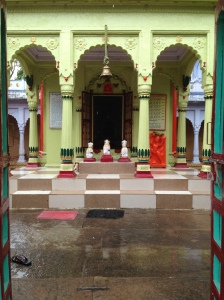
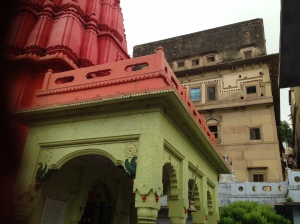
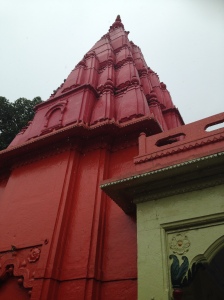
After a special aarati and sadhana at this very personal shiva temple we headed towards Lahiri Mahasaya’s home near Purana Durgaji in Chowsatti Ghat. Since the boats were banned due to the fast flowing river we made our way through the narrow familiar streets of the old city. No photographs were allowed inside so I managed to take some from the narrow street outside.
Lahiri Mahasaya’s Home as seen from the street.


Soon as I entered the house I was pleasantly surprised at the layout, which was exactly as I remembered it, the stairs coming down, the open space in the centre, this confirmation of my remembrance was very comforting as I realised it was not just an imagination of the closeness. As I bowed in front of the seat of Lahiri Baba I had a meltdown moment as past life associations came flooding out. At the same time there was a sense of a completion and I knew I did not have to come back here again. Interestingly, when my forehead touched the asan of Lahiri Baba it stuck there for an instant and I realised that some wet red paint had adhered to my forehead from my gurus temple which had been freshly painted and this now had been transferred to the seat of Lahiri Mahasaya, a smudge of red on the blanket! In small signs great connections are revealed! We received the prasad from the family members and left.
Street Food, Bovine Majestica etc.
Daily breakfast was at the corner kachori shop which would open at 8:30 and shut at 10 am. The father and son duo seemingly happy with what they make in that time. The whole day was peppered with stops at The Blue Lassi shop with wifi for a mango lassi, the Kashi Chat Bhandar on Dasashwamedha Ghat for an amazing tamatar (tomato) chat or tikki and kulfi!! Of course our progress was often marred by majestic cows and bulls on the street who had to be cajoled out of the way. 😀
On the last evening we made it for the Ganga Aarati at Dasashwamedha Ghat.
It is right that I end this with the Manikarnika Ghat or the burning ghat. From the balcony of my room I could see the constant burning pyres, a testimony to the fleeting moment of human life. This too evoked a nostalgia and yearning for I know not what.

